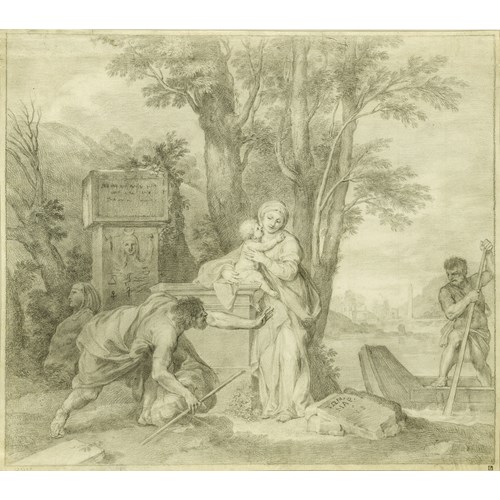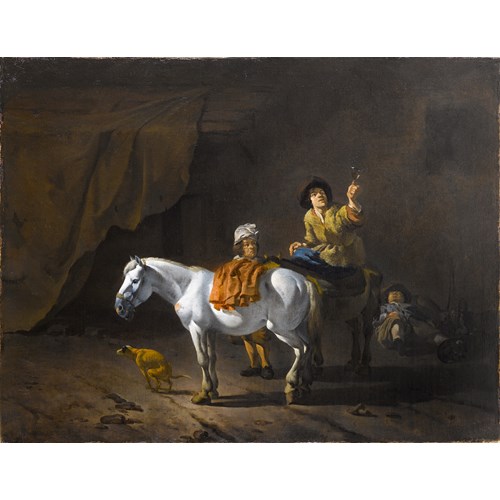Marketplace
Before Shah-i-Zinda, Samarkand
Padly Aladar
Before Shah-i-Zinda, Samarkand
Period 20th century
Origin Hungary
Medium Oil on panel
Dimension 29.7 x 40 cm (11³/₄ x 15³/₄ inches)
A market trader sits crossed legged in the cool leafy shade, his white robes catching the edge of the sun’s rays, with the rich colours of his fruit and vegetables displayed in rounded earthenware pots. To his right, on a raised platform which juts out in front of a shop, a merchant in cerulean blue robes is perched on a draped rug; behind him, a piece of sky blue slipware pottery is on view, elegantly presented on a stand. Beyond them, the painting opens up to the sunlit splendour of Shah-i-Zinda and the bright white drapes of the sheltered stalls below, which Padly Aladar has depicted in rich, heavy swathes of brushstrokes.
Often referred to as ‘street of the dead’, the Shah-i-Zinda complex, situated in the northeast part of Samarkand, is a burial site consisting of twenty sites comprised of religious building and mausoleums. The name Shah-i-Zinda, literally meaning ‘the living king’, is connected with the grave of Kusam Ibn Abbas, the cousin of the prophet Muhammad, who came to Samarkand in the seventeenth century with Arab conquerors, and who was instrumental in spreading the Islamic faith. According to one legend, Kusam Ibn Abbas descended into the Shah-i-Zinda well and gained immortality. Many courageous followers tried in vain to reach the well’s bottom but were deterred half way down by strange and intimidating visions and swiftly called for bystanders to pull them back up.
The ensemble, dating from between the eleventh and nineteenth centuries, is comprised of three groups of structures: the lower, middle and upper, which are connected by four arched domed passages, known as chartaks. Most of the buildings date back to the fourteenth and fifteenth centuries. The main body, known as the Kusam Ibn Abbas complex, is located in the north-eastern part of the group, and consists of several buildings including the Kusam Ibn Abbas Mausoleum and Mosque.
The upper grouping consists of three mausoleums facing each other. The earliest of these is the Khodja-Akhmad Mausoleum, which completes the passage from the north. The middle group is composed of mausoleums from the late fourteenth to mid-fifteenth centuries, and relates to Tamerlane’s relatives, military figures, clergy and aristocracy. On the western side is the Mausoleum of Shadi Mulk Aga, the niece of Tamerlane, with its portal dome, which was built in 1372.
The view depicted in Aladar’s Before Shah-i-Zinda, Samarkand is looking from the southeast towards this middle group of the Shah-i-Zinda complex. The wide staircase leads up from the Dargah mosque to the middle portal, or second chartak, which dates to sometime between the eighteenth and nineteenth centuries. The very same angle can be seen in a photograph by Ernst Cohn-Wiener, which dates from between 1924 and 1925.
In the upper right hand side of Aladar’s painting, the Amirzoda Mausoleum, which is characterised by its elegantly delicate ribbed dome is visible. The domed structure to its right is the Shirin Bika Aqa Mausoleum, that of Tamerlane’s sister, and before this stands the ruins of the Amir Husayn ibn Tughluq Tekin mausoleum. The staircase in Aladar’s Before Shah-i-Zinda, Samarkand would lead to the lower group of buildings, consisting of a double-cupola mausoleum dating to the beginning of the fifteenth century which is devoted to the scientist and astronomer Kazi Zade Rumi.
A further view of the Shah-i-Zinda complex in Samarkand can be seen in Richard Karlovich Zommer’s Street Scene in Samarkand, and dates from 1895.
Often referred to as ‘street of the dead’, the Shah-i-Zinda complex, situated in the northeast part of Samarkand, is a burial site consisting of twenty sites comprised of religious building and mausoleums. The name Shah-i-Zinda, literally meaning ‘the living king’, is connected with the grave of Kusam Ibn Abbas, the cousin of the prophet Muhammad, who came to Samarkand in the seventeenth century with Arab conquerors, and who was instrumental in spreading the Islamic faith. According to one legend, Kusam Ibn Abbas descended into the Shah-i-Zinda well and gained immortality. Many courageous followers tried in vain to reach the well’s bottom but were deterred half way down by strange and intimidating visions and swiftly called for bystanders to pull them back up.
The ensemble, dating from between the eleventh and nineteenth centuries, is comprised of three groups of structures: the lower, middle and upper, which are connected by four arched domed passages, known as chartaks. Most of the buildings date back to the fourteenth and fifteenth centuries. The main body, known as the Kusam Ibn Abbas complex, is located in the north-eastern part of the group, and consists of several buildings including the Kusam Ibn Abbas Mausoleum and Mosque.
The upper grouping consists of three mausoleums facing each other. The earliest of these is the Khodja-Akhmad Mausoleum, which completes the passage from the north. The middle group is composed of mausoleums from the late fourteenth to mid-fifteenth centuries, and relates to Tamerlane’s relatives, military figures, clergy and aristocracy. On the western side is the Mausoleum of Shadi Mulk Aga, the niece of Tamerlane, with its portal dome, which was built in 1372.
The view depicted in Aladar’s Before Shah-i-Zinda, Samarkand is looking from the southeast towards this middle group of the Shah-i-Zinda complex. The wide staircase leads up from the Dargah mosque to the middle portal, or second chartak, which dates to sometime between the eighteenth and nineteenth centuries. The very same angle can be seen in a photograph by Ernst Cohn-Wiener, which dates from between 1924 and 1925.
In the upper right hand side of Aladar’s painting, the Amirzoda Mausoleum, which is characterised by its elegantly delicate ribbed dome is visible. The domed structure to its right is the Shirin Bika Aqa Mausoleum, that of Tamerlane’s sister, and before this stands the ruins of the Amir Husayn ibn Tughluq Tekin mausoleum. The staircase in Aladar’s Before Shah-i-Zinda, Samarkand would lead to the lower group of buildings, consisting of a double-cupola mausoleum dating to the beginning of the fifteenth century which is devoted to the scientist and astronomer Kazi Zade Rumi.
A further view of the Shah-i-Zinda complex in Samarkand can be seen in Richard Karlovich Zommer’s Street Scene in Samarkand, and dates from 1895.
Period: 20th century
Origin: Hungary
Medium: Oil on panel
Signature: Indistinctly signed and inscribed (lower right).
Dimension: 29.7 x 40 cm (11³/₄ x 15³/₄ inches)
More artworks from the Gallery







, in a Green Dress and Pearls, Standing at a Draped _T638990626119457264.jpg?width=500&height=500&mode=pad&scale=both&qlt=90&format=jpg)

